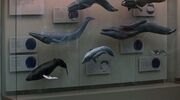Renegade54 (talk | contribs) m (grammar) |
Renegade54 (talk | contribs) m (punctuation) |
||
| (4 intermediate revisions by 3 users not shown) | |||
| Line 1: | Line 1: | ||
| + | [[File:Cetaceans.jpg|thumb|A model of a adult blue whale and a calf (right) with other cetacean models]] |
||
The '''blue whale''' (''Balaenoptera musculus'') was an aquatic [[mammal]] indigenous to [[Earth]]. It was a [[cetacean]] species. |
The '''blue whale''' (''Balaenoptera musculus'') was an aquatic [[mammal]] indigenous to [[Earth]]. It was a [[cetacean]] species. |
||
| − | Blue whales were the largest creatures ever to inhabit the Earth. By the late [[20th century]], they had nearly been hunted to extinction by [[Human]]s. |
+ | Blue whales were the largest creatures ever to inhabit the Earth. By the late [[20th century]], they had nearly been hunted to extinction by [[Human]]s. |
| + | |||
| + | Information on, a model of a mother with her baby from, and a global map showing the range of this species was included in a display of other baleen whales that was seen in the [[Cetacean Institute]] in [[1986]]. ({{film|4}}) |
||
== External link == |
== External link == |
||
* {{wikipedia}} |
* {{wikipedia}} |
||
| − | |||
| ⚫ | |||
[[de:Blauwal]] |
[[de:Blauwal]] |
||
| ⚫ | |||
Latest revision as of 18:07, 7 December 2022

A model of a adult blue whale and a calf (right) with other cetacean models
The blue whale (Balaenoptera musculus) was an aquatic mammal indigenous to Earth. It was a cetacean species.
Blue whales were the largest creatures ever to inhabit the Earth. By the late 20th century, they had nearly been hunted to extinction by Humans.
Information on, a model of a mother with her baby from, and a global map showing the range of this species was included in a display of other baleen whales that was seen in the Cetacean Institute in 1986. (Star Trek IV: The Voyage Home)
